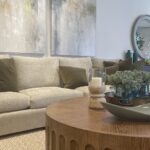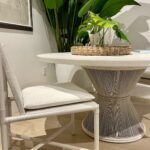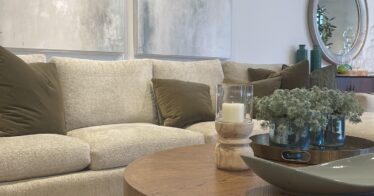This sophisticated space demonstrates how Sherwin-Williams zero VOC paints create the perfect backdrop for statement pieces. White Heron (SW7627) on the walls pairs beautifully with Niebla Azul (SW9137) above, creating an elegant canvas for a vintage Japanese gold leaf screen. Fresh tulips and blue-green textiles add vibrant, natural elements that complement the room’s sustainable paint choices. (Photo Credits: Pembrook Interiors)
The Design Challenge
A recent client consultation captured a growing sentiment among homeowners:
“We’re tired of replacing cheap materials that don’t last and feel generic. We want to renovate our home with materials that are built to last and are better for the environment. Where do we even start with sustainable options that are worth the investment? What is your tip for a non-structural eco-friendly interior design investment?”
Understanding the True Cost of Material Choices
This question cuts to the heart of thoughtful home design. When we talk about “cost,” we need to look beyond the price tag.
The true cost of any material includes not just the initial purchase, but transportation, installation, maintenance, and eventually, disposal. Many seemingly budget-friendly options become surprisingly expensive when you consider their short lifespan and environmental impact.
When we are crafting interiors, our time horizon for design element investment is a minimum of 10 years. In other words, our objective is that you will love your space and expect it to function well for at least 10 years. Good design is not disposable, and in fact, good design translates easily from one space to the next and will have many uses beyond the 10-year mark.
In addition, thoughtfully chosen materials and created spaces contribute to what designers call “neuroaesthetics“—how our brain responds to our environment.
Well-designed spaces with high-quality, sustainable materials don’t just look better—they feel better and contribute to our overall well-being.
Quality materials also mean higher indoor air quality, which is also a primary consideration of our designs.
In this article, we’re calling balls and strikes, outlining the key considerations that we would walk through with our clients in a discussion of four sustainable home products that you may not have previously considered.
These products offer excellent long-term value while creating healthy, beautiful living spaces. The last product is our suggestion for a way to start small, if for instance you’re not making structural changes in your home.
Let’s dive in...
Recycled Glass Countertops: Beauty from Waste
Recycled glass countertops transform post-consumer and industrial glass waste into stunning, durable surfaces that rival natural stone in both beauty and performance. They’re heat-resistant, non-porous, and available in an array of colors and patterns.
However, transportation impacts and significantly affects their overall environmental benefits, which is why we often recommend IceStone for our Mid-Atlantic and Northeast projects, as they manufacture in Brooklyn, NY. For Southeast projects, Vetrazzo, made in Georgia, offers excellent options with minimal transportation impact.
Our Recommendation:
While glass countertops can be durable, they may be susceptible to chipping, scratching, or heat damage if not properly maintained or if exposed to heavy impact. The durability of recycled glass countertops can vary depending on factors such as the quality of the recycled glass and the manufacturing process used.
Recycled glass countertops may have visible imperfections or inconsistencies, such as air bubbles, color variations, or uneven textures, which are inherent characteristics of recycled materials. While these imperfections can add character and uniqueness to the countertop, they may not appeal to homeowners seeking a more uniform appearance.
When considering recycled glass countertops, sourcing location materially impacts the environmental footprint of this product. For this reason, we suggest careful sourcing of the materials due to the transportation considerations and key differences in the manufacturing process that alter the durability and appearance of the product.
You can learn more about eco-friendly countertop options in the Elemental Green Staff article “15 Fabulous Eco-Friendly Countertops for Kitchens or Baths.”
Linoleum: The Sustainable Design Chameleon
True linoleum, often confused with vinyl, is made entirely from natural materials: linseed oil, pine resin, wood flour, cork dust, and jute backing. This renewable, biodegradable flooring option offers unmatched durability and design flexibility.
We particularly love Forbo Marmoleum for its extensive design options and proven track record. Their transparent supply chain and commitment to sustainability make them an industry leader.
Our Recommendation:
Linoleum flooring offers versatility in design, with a wide range of colors, patterns, and textures available to suit any aesthetic preference. Whether you prefer a classic look with solid colors or a more contemporary style with vibrant patterns, linoleum can accommodate various design schemes and architectural styles.
Maintenance is straightforward, requiring only regular sweeping and occasional mopping with a neutral pH cleaner. With proper care, linoleum floors can keep their beauty and integrity for decades, making them a long-term investment in both sustainability and style that contributes to healthier indoor air quality.
We especially recommend it for high-traffic areas like mudrooms, kitchens, pool houses, or game rooms. It’s an excellent choice for vacation rental properties, given its durability and unlimited design possibilities. For more insights into linoleum’s remarkable comeback, check out the feature in Architectural Digest “The Linoleum Renaissance Is Upon Us, and Earth Is a Fan.“
Zero-VOC Paint: Healthy Walls, Healthy Home
Modern zero-VOC paints have transformed the market, offering healthy alternatives without compromise. Sherwin-Williams’ ProMar 200 Zero VOC Interior Latex Paint and Duration Home lines stand out for their zero-VOC formulas, while Benjamin Moore’s Natura® collection has earned third-party certification for environmental safety.
These paints now offer the same rich colors and durability as traditional options, with costs comparable to other premium paints.
Our Recommendation:
Despite slightly lower durability compared to traditional paints, we strongly recommend Zero-VOC paint, especially for bedrooms and for occupants with allergies, asthma, or chemical sensitivities. At a minimum, we use low-VOC paint (in contrast to zero-VOC paint) throughout the rest of the home to support healthy indoor air quality.
Recent technological improvements have largely addressed early concerns about durability and color variety. Sherwin-Williams’ ColorCast Ecotoner® system allows any color to be mixed while maintaining zero VOC status—from subtle neutrals like White Heron (SW7627) to richer hues like Niebla Azul (SW9137).
The zero-VOC formula meets the most stringent VOC requirements while offering rated durability (washable and scrubbable) and excellent coverage. Available in multiple sheens and all colors, including deep and vivid accent colors, it’s become a standard recommendation for our interior design projects.
For more insights into creating healthy spaces with zero-VOC paints, particularly in children’s rooms, check out the article “How to Make a Sustainable Bedroom for Kids” in Eco Home Magazine.
Artisan-Made Recycled Glass Lighting: Where Sustainability Meets Artistry
When we think about sustainable design choices, lighting often gets overlooked. Lighting is a non-structural solution to eco-friendly interior design investment. Specifically, artisan-made recycled glass lighting represents one of the most impactful ways to transform a space while supporting environmental consciousness.
Recently, we had the opportunity to meet with Julie Conway, founder of Seattle-based Illuminata Art Glass Design, whose work exemplifies the extraordinary potential of sustainable lighting design with her readymade series LUMi Collection.
With over 24 years of experience, Conway transforms recycled glass into bespoke lighting installations that transcend mere functionality to create what she calls “transcendent moments.” Her approach perfectly embodies the intersection of sustainability, artistry, and practical design that we advocate for in thoughtful home design.
Our Recommendation:
Artisan-made, small-batch recycled glass lighting offers unique advantages that mass-produced fixtures simply can’t match. In Conway’s glasswork, for example, each piece is conceived and executed with intent to transform spaces through the interplay of light and glass.
The process involves not just the creation of beautiful glass forms, but also the engineering of custom suspension systems and seamless integration of technical components.
This customization translates to a lighting solution that ideally suits the space and the occupants. At Pembrook Interiors, we are not just changing your home, we are changing how it feels to live there, and Conway’s artisan, recycled glass lighting is a key secret to how we create a “feeling in a space.”
While the initial investment in artisan-made lighting may be higher than mass-produced alternatives, these pieces offer extraordinary value in terms of their lasting appeal and quality.
Additionally, Conway* is melting post-consumer bottles headed for the landfill, instead of relying on new raw materials, to craft lighting creations that serve as both functional lighting and art installations that often become a linchpin of the home’s design.
Upcycled materials and local craftsmanship significantly reduce the environmental impact compared to imported fixtures that are traveling around the world on container ships.
*Conway has been recognized for her efforts taking #5 in the Decorative Kit Category at London’s DARC Awards, an international lighting award, for her BOLA Eco Pendant in 2024.
For residential projects, we love using artisan-made recycled glass lighting for spaces where impact matters—entry foyers, dining rooms, or great rooms with high ceilings.
These installations can transform otherwise ordinary spaces into extraordinary ones while telling a compelling story of sustainability and artistic vision.
In addition, these eco-friendly interior design investments are often easily transferred to future homes. Reimagining the new use for specialty lighting moved from one home to the next is something that we routinely do for our design clients, so lighting investment is one that moves with you.
Ready to Make Sustainable Choices?
Choosing eco-friendly interior design materials isn’t just about being sustainable—it’s about making thoughtful investments in your home’s future and your well-being. These materials create spaces that look beautiful, feel authentic, and contribute to both personal and planetary health.
By considering the full lifecycle of our design choices, we create homes that reflect you and that are truly built to last.
Contact us today to explore how these sustainable materials can transform your space while reducing your environmental footprint. We’ll help you navigate the options and make choices that align with both your values and your vision for your home.









